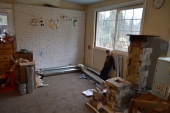
 3
3




 1
1




 7
7




 1
1




 3
3




Mark DuPont wrote:Mason stove builders have cautioned me against relying upon the CFB in the burn chamber and advised me to use full fire brick. I realize there is a lower efficiency due to the heat absorbed by the brick, but the mason builders tell me this is not a big deal, the stove still functions wonderfully, especially once it warms up, and do I really need 2000 F in my stove anyway? I want a stove that's going to hold up to years of stoking and the inevitable abuse when someone other than me uses it. I've seen photos of CFB in pretty rough shape. I've puzzled over ways to line the core with brick splits, but they seem to be just floating in the combustion chamber, dry stacked, with no anchor or attachment, and it seems inevitable they will, sooner or later, split and/ or fall.
Mark DuPont wrote:One place I am still considering using CFB is the riser - it seems reasonably safe there, away from the wear and tear of loading firewood etc, but does it hold up long term to the heat? I see some photos where it looks like CFB has just melted from the heat after prolonged exposure. I like the idea of a CFB riser, but I'd rather not have to tear my RMH apart after 5 years just to replace a riser that i could make out of a more durable material.
Silence is Golden
For all your RMH needs:
dragontechrmh.com
 1
1




As far as how hot you burn, if the temperature isn't high enough, certain gasses will not combust to give a complete burn and you might as well just be building a regular wood stove that burns much cooler (and often dirtier).
My batch box is made from dense firebrick splits and adhered with fire cement. Half a season and are still intact and not shifting though I am very careful loading and am the only one who uses the stove so that can make a huge difference.





 3
3




For all your Montana Masonry Heater parts (also known as) Rocket Mass heater parts.
Visit me at
dragontechrmh.com Once you go brick you will never go back!
 1
1




 1
1




I don't own the plants, they own me.




On the core build I'm working on, my compromise for the possible fragility of CFB is to just line the firebox with loose CFB that I can easily replace when needed. Since they're single pieces, no worries about them staying in place like fire bricks. The bottom piece locks the sides in. The only drawback is, you have to account for the extra space for replaceable CFB in your design measurements.
 1
1




Mark DuPont wrote:Nice idea Matt. how long have you been doing this? How often do you find the CFB needs replacing? Does it ever weld or stick to the layer behind it?
I don't own the plants, they own me.




Mark DuPont wrote:Gerry - What is behind your firebrick splits? Are they backed with regular firebrick, or some kind of insulation?
Silence is Golden
For all your RMH needs:
dragontechrmh.com




 2
2




For all your Montana Masonry Heater parts (also known as) Rocket Mass heater parts.
Visit me at
dragontechrmh.com Once you go brick you will never go back!
 2
2




 2
2








As far as how hot you burn, if the temperature isn't high enough, certain gasses will not combust to give a complete burn and you might as well just be building a regular wood stove that burns much cooler (and often dirtier).




 2
2




Silence is Golden
For all your RMH needs:
dragontechrmh.com
 2
2




Scots John wrote:As I understand it, if you just used firebrick with no backing insulation then what would happen is, the fire would keep heating the bricks until the heat saturated the brick, at that point they would not get any hotter because the brick is now loosing heat to the air.
If you use insulation then once the brick reaches saturation point the insulation stops it escaping so... the brick gets hotter?
Silence is Golden
For all your RMH needs:
dragontechrmh.com




 2
2




Silence is Golden
For all your RMH needs:
dragontechrmh.com
 1
1





|
You showed up just in time for the waffles! And this tiny ad:
Support permies and give beautiful gifts to gardeners: permaculture playing cards.
https://gardener-gift.com/
|







